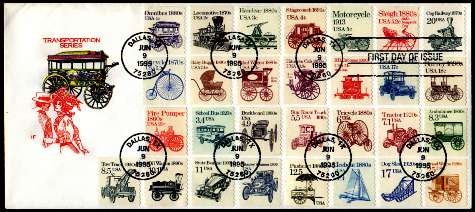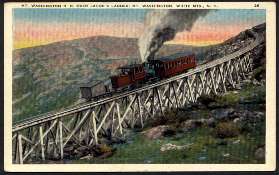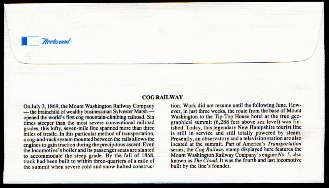20¢ COG RAILWAY COIL - June 9, 1995
(Final transportation Coil design)

Sc. 2463 - issued 6/9/95
|
|
The following text is from the USPS First Day Ceremony Program for this
stamp, held at Texpex '95 in Dallas, Texas, June, 9, 1995
With their tilted boilers and balloon smokestacks, the Cog Railway Cars have often been
referred to as funny little engines, but their odd design and special gearing
adapt them well to the task of climbing.
Cog Railway Cars were invented from an idea of Sylvester Marsh, a 54 year-old retired
businessman from New Hampshire. After climbing to the top of Mount Washington, Marsh
began to think of a safer and easier way to reach the summit. A railroad seemed to be the
most promising idea, for if he could build an engine capable of aacending such grades, It
could transport materials to build the track as it went along.
Some of the earliest locomotives employed central or outer cog rails
for propulsion. They were built to transport coal from mines, but no one had ever
attempted to build a cog locomotive that was intended to climb a mountain or any other
such comparable grade.
Conventional locomotives are propelled by adhesion of the wheels to
the rails and can climb only short, seven to nine percent grades. A Cog Railway
locomotive can climb much steeper grades.
|
The engine's reduced gear ratio enables it to climb steep grades, its
ratchet keeps it from rolling backwards while doing so, and it can descend at a safe
speed by compressing air in the steam cylinders.
Cog Railway engines were running before the existence of television, ailplanes,
automobiles, even the electric light, and so many other devices we commonly take for
granted.
There are currently about fifly-five Cog Railway Cars in the world.
The first, built in New Hampshire, is the Mount Washington Cog Railway which has been in
operation since 1869, and is still using much of its original equipment.
The Cog Railway Cars of Manitou and Pikes Peak Railway Company in
Colorado ascend sections of twenty-five percent, with an average grade of fifteen
percent, and climb the highest elevation gain of any Cog Railway car in the world.
The science of mountain railroading, however, has been perfected in
the high Alps of Switzerland, where there are twenty-five Cog Railways.
|
This stamp was announced as the last of the
Transportation Coil designs, and that added
a nice philatelic element to the issue, on which many cachet-makers capitalized. The
pair of covers below contains all 51 of the subjects issued, and all 57 of the different
major varieties, excluding the precancels and some subtler variations in paper and
tagging. By my count there were 104 different Transportation coils, including all those
additional varieties, when I stopped collecting them a couple of years ago. There are
probably a few more by now.
See if you can figure out why the cachet maker chose to arrange the
stamps as he did - I'm still pondering that question.

Sc. 2463 FDC set with all the Transportation Coil designs
|

Sc. 2463 FDC set with all the Transportation Coil designs
|
The postcard below, from about 1920 by my reckoning, was not mailed, but has the
following penciled text on the back:
Going over Jacob's Ladder it just seems as though you were suspended
in mid air with nothing around you but the clouds and you begin to think if anything gave
way on that train it would roll off the tracks and drop to the bottom.

Postcard with image of Mt. Washington Cog Railway
|
Below is the Fleetwood First Day Cover for this issue, with some interesting additional
information.

Sc. 2463 - Fleetwood FDC
|

Sc. 2463 - Fleetwood FDC
|
|











